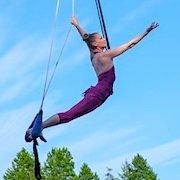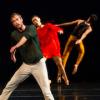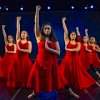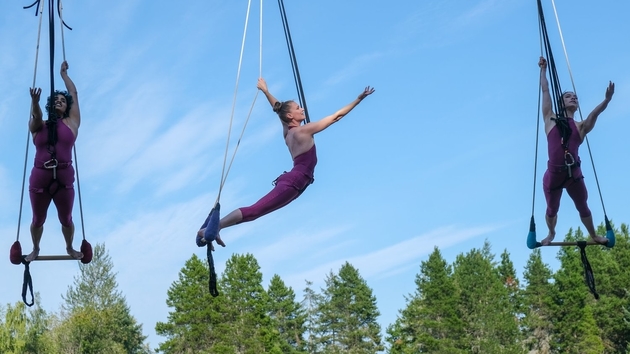
Sky and land seamlessly unite when a celestial goddess suspended in a gigantic overhead snow globe swirls and floats on composer/musician David Worm’s earthy, blues-inflected sound score. Spirit and substance mingle as violist Sahib Amar Kaur Khalsa uses a sixth sense to intuit the subtle adagio timing of a dancer, ascending a tissu (an aerial silk), or spiraling slowly on a lyra ring. Earthy textures and ethereal tonal range expand with multi-instrumentalist Amar Singh Khalsa, a versatile performer who introduces flute, clarinet, percussion, and vocal responses to the fluid emotions and physicality of the UpSwing Aerial Dance Company.
The visceral, combined power of music and movement to transport and uplift souls is unleashed in Solstice!, a ninth-anniversary celebration of the Berkeley-based company’s biannual holiday presentation. Held in UpSwing’s intimate studios that are transformed into a performance space by stage lighting and “Terrestrial Extremities,” a winter photo exhibit by Beth Zuckerman, two performances Dec. 21 and 22 mark the year’s longest night/shortest days.
UpSwing Artistic Director Cherie Carson is a choreographer, dancer, aerialist, teacher, and interdisciplinary artist. After moving to the Bay Area in 2000, she studied with aerialist Terry Sendgraff, among others, eventually buying her teacher’s business. Establishing a strong school emphasizing safety and artistry, Carson developed a unique choreographic voice with contemporary dance works drawing from classical ballet, modern dance, aerial and circus arts, cinema, theater, and improvisation.
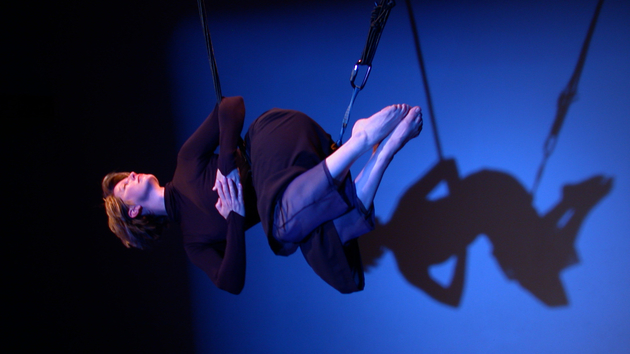
Music is as central to her creative process as is dance, she says in an interview. “I love to work with musicians with the willingness to improvise. For Solstice, David has a background with Bobbie McFerrin and has his hands in many pots. When the audience walks into our magical wonderland, he and his singers with him will be creating a sound score.”
Worm might render percussion or altered vocal versions of popular songs woven into a score with original songs he has written. “I’ve worked with him since 2006, whatever he does, he’s seamless with our actions on the silks,” Carson says. “Sahib and Amar do an opening song. They bring us from dark to light in this piece that isn’t about Christmas but is about light. It’s a slow build to a place where the audience is really happy.”
Trust is therefore not just what dancers build on aerial apparatus during hours manipulating their bodies high above ground on trapeze, tissu, slings, ropes, harness, bungee cords, and invented equipment. Trust between Carson and the dancers and musicians is essential and comes with time and diligent practice. Superior in-the-moment focus is crucial. “Sahib is mild as a performer, not as outgoing as Amar or as charismatic as David, but her ability to support the dancer — the dancer whose timing isn’t always the same — Sahib watches intently and catches the emotion of it all,” she says.
The themes of Solstice remain the same, year after year: “We’re making an expression that is multifaceted with dance, live music, and visual arts all together. We’re giving a sensory feeling, moving from dark to light, taking in the feeling of the longest night with our voices and bodies.”
Even so, Carson introduces new elements with each iteration. This year, she’s including an excerpt from a work made in 1995. “It’s about saying goodbye. It’s an expanded moment about that trigger in your mind when you let go of something and move on. I feel we’re in need of moving on. The way we’ll grow as a community and even as the United States ... well, we can’t keep the same rhythm if we’re going to be successful.”
For the first time, Carson will hold a preshow talk in the Grand Hall. “It’s just to give people a little bit of what I’m thinking. People come with their own stuff and I don’t want to color it too much, but a little context will support them as they walk into the show.”
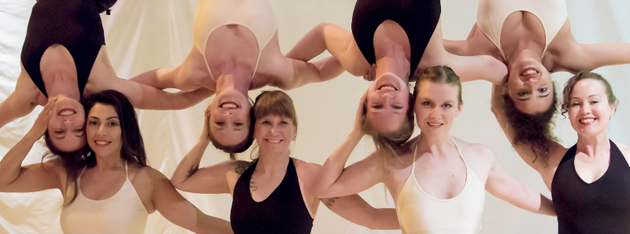
Carson is likely to mention the evening’s final dance, inspired by the energy she observed in the northern lights last March. Set to Phillip Glass’s Mad Rush, the 14-minute, seven section minimalist score includes the composer’s usual loops and repetition, but also dynamic range in shifting tempos. “The music just resonated with me; it moves you through time. And dance take us through time with motion.” She recalls how the lights were sometimes mere wispy streams across the sky and at other times expanded, contracted, bounced, twinkled, and disappeared.
Variety applied to circus arts skills means UpSwing’s dancers explore every possible way for getting on and off the equipment. “We know certain forms that are known in the circus world, but we’re not just doing one trick after another,” she says. Asked about the impact of the enormously popular Cirque de Soleil on audiences and expectations, she says, “I appreciate it, but I’m not intimidated by it and we’re not trying to be a spectacle. What we give is true beauty. If you pay attention to one dancer during a show, is it because they’re a technician, or is it a person who’s communicating with you? That’s what we strive for in dance that may not be found in something that strives for perfection. I love and admire those things, but it’s not us. We’re not circus arts. We’re a blend of dance on the ground and sculpting the air on aerial apparatus.”

